
Join the live broadcast from the third annual MilSat Symposium conference.
Keynote will begin at 10:00 AM Pacific Time on October 19th.

Join the live broadcast from the third annual MilSat Symposium conference.
Keynote will begin at 10:00 AM Pacific Time on October 19th.
Join the live broadcast from the seventh annual Satellite Innovation conference.
Keynote will begin at 9:15 AM Pacific Time on October 17th.
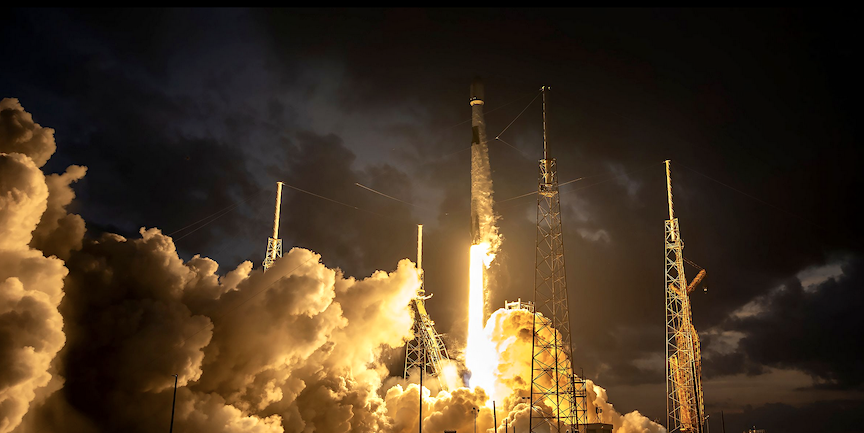
On Friday, October 13 at 7:01 p.m. ET, Falcon 9 launched 22 Starlink satellites to low-Earth orbit from Space Launch Complex 40 (SLC-40) at Cape Canaveral Space Force Station in Florida.
This was the 14th flight for the first stage booster supporting this mission, which previously launched CRS-22, Crew-3, Turksat 5B, Crew-4, CRS-25, Eutelsat HOTBIRD 13G, mPOWER-a, PSN SATRIA, and now six Starlink missions.

SpaceX is targeting Friday, October 13 at 7:01 p.m. ET for a Falcon 9 launch of 22 Starlink satellites to low-Earth orbit from Space Launch Complex 40 (SLC-40) at Cape Canaveral Space Force Station in Florida. If needed, five backup opportunities are available starting at 7:51 p.m. ET until 10:29 p.m. ET. Five backup opportunities are also currently available on Saturday, October 14 starting at 6:36 p.m. ET until 9:51 p.m. ET.
A live webcast of this mission will begin on X @SpaceX about five minutes prior to liftoff.
This is the 14th flight for the first stage booster supporting this mission, which previously launched CRS-22, Crew-3, Turksat 5B, Crew-4, CRS-25, Eutelsat HOTBIRD 13G, mPOWER-a, PSN SATRIA, and five Starlink missions. Following stage separation, the first stage will land on the A Shortfall of Gravitas droneship, which will be stationed in the Atlantic Ocean.
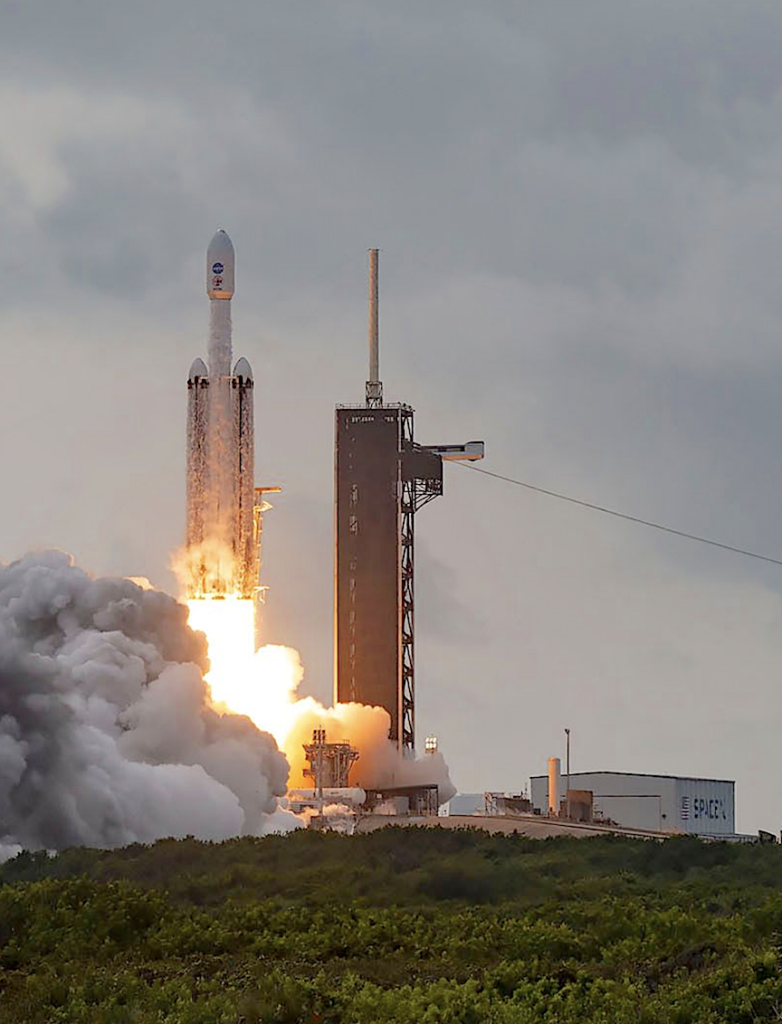
UPDATE 2: On Friday, October 13 at 10:19 a.m. ET, Falcon Heavy launched NASA’s Psyche mission to an interplanetary transfer orbit from Launch Complex 39A (LC-39A) at Kennedy Space Center in Florida. This was the fourth launch for the side boosters, both of which previously supported the USSF-44, USSF-67, and Hughes JUPTER 3 missions.
The Psyche spacecraft will travel to a metal-rich asteroid of the same name orbiting the Sun between Jupiter and Mars in pursuit of studying the exposed nickel-iron core of an early planet, one of the building blocks of the solar system. The mission will also demonstrate NASA’s first deep space test of the Deep Space Optical Communications (DSOC) system – high-bandwidth optical communications through space and back to Earth – from distances far exceeding the Moon – using a near-infrared laser.
This is the first official interplanetary mission for SpaceX with the exception of Falcon Heavy’s debut test flight in February 2018 sending CEO Elon Musk’s Tesla Roadster past the orbit of Mars.
Rather than recovery of the core booster on one of SpaceX’s autonomous drone ships in the Atlantic Ocean, maximum fuel was allotted to ensure Psyche’s nominal trajectory went smoothly.
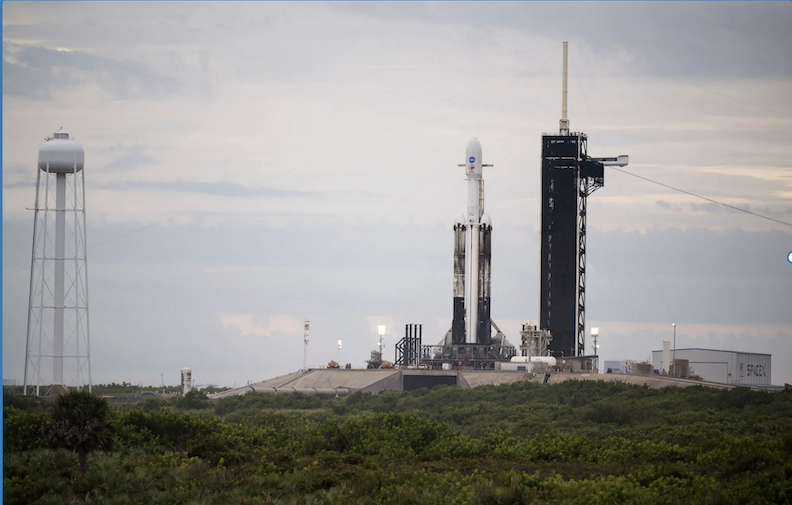
UPDATE: NASA and SpaceX are standing down from the October 12 launch of the agency’s Psyche mission due to unfavorable weather conditions. NASA and SpaceX are now targeting launch at 10:19 a.m. EDT Friday, October 13, from Launch Complex 39A at Kennedy Space Center in Florida.
The live launch broadcast with commentary will begin at 9:30 a.m. EDT on the NASA Television public channel and also will air on YouTube, X, Facebook, Twitch, Daily Motion, the NASA app, and the agency’s website.
A SpaceX Falcon Heavy rocket with the Psyche spacecraft onboard is seen at Launch Complex 39A as preparations continue for the Psyche mission, Wednesday, Oct. 11, 2023, at NASA’s Kennedy Space Center in Florida. NASA’s Psyche spacecraft will travel to a metal-rich asteroid by the same name orbiting the Sun between Mars and Jupiter to study its composition. The spacecraft also carries the agency’s Deep Space Optical Communications technology demonstration, which will test laser communications beyond the Moon.
The spacecraft is targeting an Oct. 12 liftoff atop a Falcon Heavy rocket. Its destination, a metal-rich asteroid, may tell us more about how planets form.
The spacecraft is targeting an Oct. 12 liftoff atop a Falcon Heavy rocket. Its destination, a metal-rich asteroid, may tell us more about how planets form.
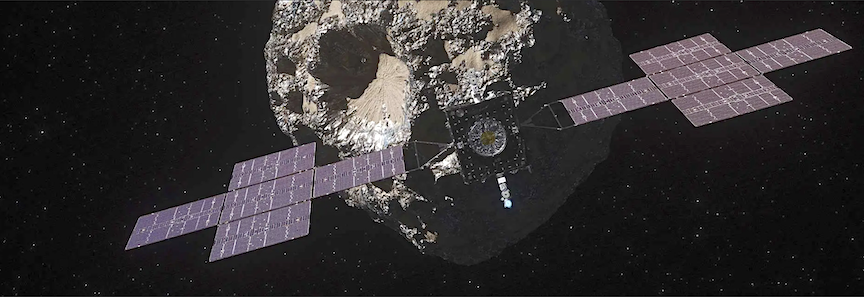
In less than 24 hours, NASA’s Psyche spacecraft is slated to launch from the agency’s Kennedy Space Center in Florida. With its sights set on a mysterious asteroid of the same name, Psyche is NASA’s first scientific mission to be launched on a SpaceX Falcon Heavy rocket.
Launch is set for 10:16 a.m. EDT on Thursday, October 12, with additional opportunities identified each day through October 25. Each opportunity is instantaneous, meaning there is only one exact time per day when launch can occur.
“The team has worked tirelessly to prepare the spacecraft for its journey to a one-of-a-kind asteroid,” said Henry Stone, Psyche’s project manager at NASA’s Jet Propulsion Laboratory in Southern California. “All spacecraft systems, science instruments, and software have been integrated and extensively tested, and the spacecraft is fully configured for flight. We look forward to the launch and – more importantly – to accomplishing the mission’s objectives, marking yet another historic voyage of scientific discovery.”
The orbiter’s solar arrays are folded and stowed for launch. All systems have been tested and re-tested many times, along with the payload of three science instruments. Loaded with 2,392 pounds (1,085 kilograms) of the neutral gas xenon – the propellant that will get Psyche to the asteroid belt – the spacecraft sits inside the launch vehicle’s cone-shaped payload fairing, which protects it from aerodynamic pressure and heat during launch. The spacecraft and fairing have been mated to the SpaceX Falcon Heavy, which is poised for takeoff from Kennedy Space Center’s historic Launch Complex 39A.
Integrated onto the spacecraft is a technology demonstration called Deep Space Optical Communications (DSOC). DSOC will test high-data-rate laser communications – which could be used by future NASA missions – beyond the Moon for the first time. The tech demo will not relay Psyche mission data.
The rocket has two stages and two side boosters. After the side boosters separate and return to land, the core stage will be expended into the Atlantic Ocean. Then the second stage of the rocket, which will help Psyche escape Earth’s gravity, will fire its engine.
Once the rocket is out of Earth’s atmosphere, about four minutes after launch, the fairing will separate from its ride and split into two halves, which are jettisoned back to Earth. The spacecraft will then separate from the upper stage about an hour after launch. Soon after, it will deploy its twin solar arrays, one at a time, and direct them at the Sun. At this point, the spacecraft is in a planned “safe mode” (a precautionary standby status), with the Sun illuminating the deployed solar panels, and will begin to direct the low-gain antenna toward Earth for communications.
It could take up to two hours after separation from the rocket before the first signal is received.
Once stable communications have been established, mission controllers will begin to reconfigure the spacecraft into its planned operating mode. The ensuing three months of initial checkout include a commissioning phase to confirm that all hardware and software is operating as expected, including the electric thrusters. Starting about five months after launch, the thrusters will fire, one at a time, during long stretches of the trajectory to get to the asteroid.
Psyche’s efficient solar electric propulsion system works by accelerating and expelling charged atoms, or ions, of the neutral gas xenon – creating a thrust that will gently push the spacecraft on a journey of nearly six years and about 2.2 billion miles (3.6 billion kilometers) to the asteroid Psyche in the main asteroid belt between Mars and Jupiter.
Along the way, in May 2026, the spacecraft will fly by Mars and use the Red Planet’s gravity to slingshot itself toward Psyche, saving propellant while gaining speed and changing direction.
After the spacecraft reaches the asteroid in 2029, it will spend about 26 months in orbit, gathering images and other data.
Scientists believe Psyche could be part of the core of a planetesimal – an early planetary building block – and composed of a mixture of rock and iron-nickel metal. The metal will not be mined; it will be studied to give researchers a better idea of what makes up Earth’s core and how rocky planets formed in our solar system. Humans can’t bore a path to our planet’s core – or the cores of the other rocky planets – so visiting Psyche could provide a one-of-a-kind window into the violent history of collisions and accumulation of matter that created planets like our own.
Arizona State University leads the Psyche mission. A division of Caltech in Pasadena, JPL is responsible for the mission’s overall management, system engineering, integration and test, and mission operations. Maxar Technologies in Palo Alto, California, provided the high-power solar electric propulsion spacecraft chassis.
JPL manages DSOC for the Technology Demonstration Missions program within NASA’s Space Technology Mission Directorate and the Space Communications and Navigation program within the Space Operations Mission Directorate.
NASA’s Launch Services Program, based at Kennedy Space Center, is responsible for the insight and approval of the launch vehicle and manages the launch service for the Psyche mission. LSP certified the SpaceX Falcon Heavy rocket for use with the agency’s most complex and highest priority missions in early 2023 at the conclusion of a 2 ½-year effort.
Psyche is the 14th mission selected as part of NASA’s Discovery Program, managed by the agency’s Marshall Space Flight Center in Huntsville, Alabama.
For more information about NASA’s Psyche mission go to: http://www.nasa.gov/psyche
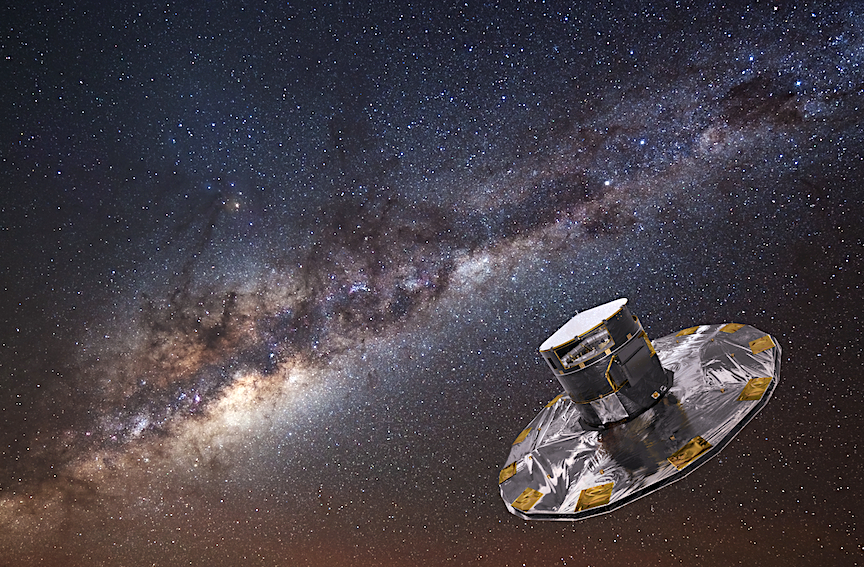
The Gaia satellite has been charting the sky since 2014, and its map includes stars that are a million times fainter than can be seen with the naked eye. Published in June 2022, the third version of the most complete and detailed catalogue of stars (Gaia DR3) is a milestone in astrophysical research. Gaia’s exceptionally accurate distances, motions and fundamental parameters of stars, as well as the classification of quasars and the accurate astrometry of asteroids are now part of the everyday work and research of most astronomers.
One of the showpieces of the newly released data is the globular cluster Omega Centauri. The cluster contains about 10 million stars very densely packed on the sky, challenging Gaia to resolve them. In view of Gaia DR4, various techniques are foreseen to process the data in the densest and most interesting regions. The reprocessing of the Omega Centauri cluster allowed recovering the astrometry and photometry of 526,587 more stars located in its core.
While Gaia observes the same stars several times and at different epochs, until now ESA only published averaged measurements. It did not prevent Gaia to identify variable stars, but characteristics such as their instant photometry and radial velocities used in the classification process are not published, yet. As we await Gaia DR4 where all observations (epoch and averaged) will be available, a partial publication of the highest quality time series of data acquired for 9164 Long Period Variables is part of these Focused Product Releases, and will help the scientific community to prepare for the wealth of data Gaia will deliver in 2025.
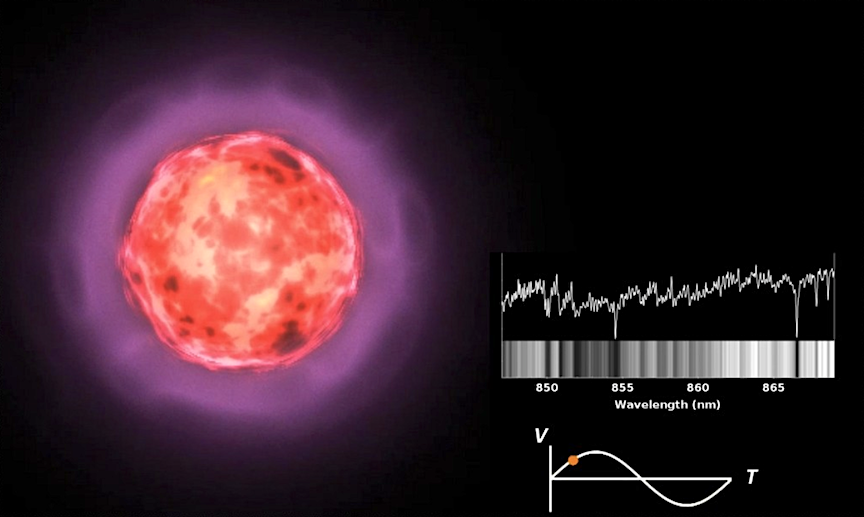
The ESA-Gaia spacecraft has repeatedly observed the spectrum of an unprecedented amount of cool giant stars – called Mira variables – known to continuously expand and contract their surfaces over long periods, sometimes of more than one year. This artist´s impression of a Mira star shows how the velocity of the surface movements and of its atmosphere are accurately measured from the (Doppler) shifts of dark lines observed in the detailed Gaia spectra. A video animation is here.
The space between stars is not completely empty. It is filled by low-density gas made of atoms, ions and molecules as well as by dust. This interstellar matter absorbs and scatters the light, producing a continuous reddening and weakening of the stellar flux. Additional broad features, named Diffuse Interstellar Bands, also appear in the spectra of stars. They are due to absorption likely associated with very complex molecules found in the interstellar medium in certain directions. Such Diffuse Interstellar Bands are present in the Gaia Radial Velocity Spectrometer’s wavelength range and are used to trace its formation in the Milky Way disk and its spiral arms.

At one end of its distance scale, near the limit of our observable universe, Gaia detects quasars. In the sky, some of these can be very close to a massive galaxy and have their light path bent by the galaxy’s gravitational well, as if it went through a lens. The lensing phenomenon produces a gravitational mirage that can be used to directly estimate the age and the expansion rate of the Universe. During the last months, Gaia teams identified 381 new candidate lensed quasars and mirages.
At the other end of the distance scale, Gaia teams reprocessed 156 764 asteroids, but using 66 months of data rather than the 34 months of Gaia DR3. Thus, the observations of most main-belt asteroids now cover a complete revolution around the Sun, closing the orbit, leading to a dramatic increase in the accuracy of the orbits.
The expertise of the astrophysicists from the KU Leuven, Royal Observatory of Belgium, Université libre de Bruxelles, Universiteit Antwerpen and Université de Liège plays an important role in the processing and analysis of Gaia data in general, and in the implementation of the focused product releases in particular. They are supported in their efforts by the Belgian Federal Science Policy Office (BELSPO) via the PRODEX Programme of ESA. In addition to providing new data to complement the third version of the Gaia catalogue, the Focused Product Releases are a proof-of-concept of various new features implemented in the data analysis pipeline producing Gaia DR4 with twice more data. They offer a necessary and useful overview of all the promises that the fourth version of the catalogue will fulfill.

Relativity Space has signed a multi-year, multi-launch, Launch Services Agreement (LSA) with Intelsat wherein the company will launch Intelsat satellites on the firm’s Terran R launch vehicle as early as 2026.
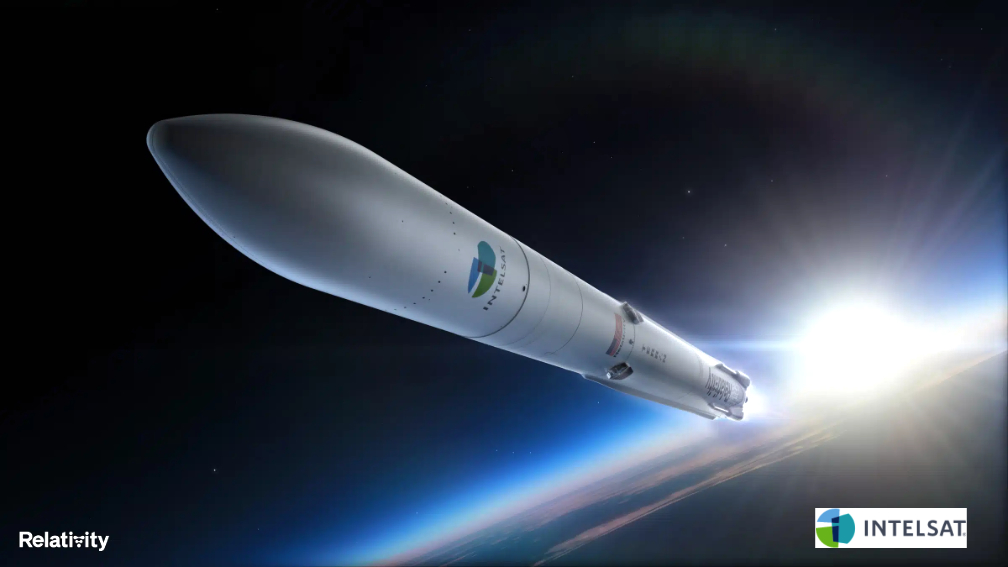
As a medium-to-heavy-lift, reusable launch vehicle made for growing satellite launch demand, and eventually multi-planetary transport, Terran R provides government and commercial customers affordable access to space, in LEO, MEO, GEO and beyond. Relativity has a total of nine signed customers for Terran R, including multiple launches and totaling more than $1.8 billion in backlog.
Terran R was developed to accommodate the growing demand for large constellation launch services. With a payload fairing that offers the correct market fit to meet a variety of needs, Terran R supports use cases from dedicated payload deployments of constellation customers or single geosynchronous satellites to rideshare configurations for multiple customers per launch. Putting customers first, Relativity is designing and manufacturing rockets that offer high performance and reliability, while costing less to produce and fly.
Terran R is designed and manufactured at Relativity’s headquarters in Long Beach, California, which is home to the firm’s 4gen Stargate metal 3D printers. Stage and engine testing is conducted at NASA’s Stennis Space Center in Mississippi and Terran R will launch Intelsat missions from Space Launch Complex 16, Relativity’s orbital launch site at Cape Canaveral Space Force Station in Florida.
“We are honored to be working with Intelsat to launch future spacecraft into their industry leading satellite fleet. They have an incredible company and team as a world leader in content connectivity with nearly 60 satellites already in orbit. The space industry clearly requires more commercially competitive, diversified, and disruptive launch capacity. Relativity is developing Terran R as a customer-focused reusable launch vehicle to solve this need. We look forward to planning, executing, and successfully launching these missions together with Intelsat.” — Tim Ellis, Co-Founder and CEO, Relativity Space
“After 60 years of commercial satellite launches, Intelsat and our customers have come to expect reliability, efficiency and flexibility from our launch providers. Relativity has developed an innovative design and production process for the Terran R, which will deliver benefits to Intelsat for years to come.” — Jean-Luc Froeliger, Senior Vice President of Space Systems, Intelsat
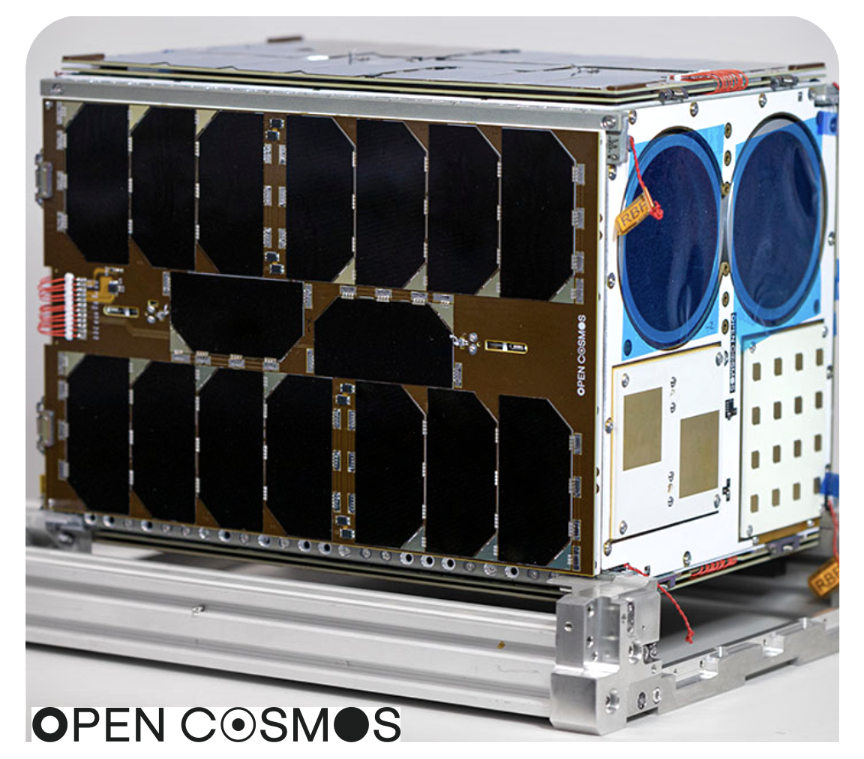
Open Cosmos and the European Space Agency (ESA) have announced plans for the launch of the MANTIS satellite aboard the upcoming SpaceX Transporter-9 mission — this mission was arranged jointly by SAB Launch Services and Exolaunch.
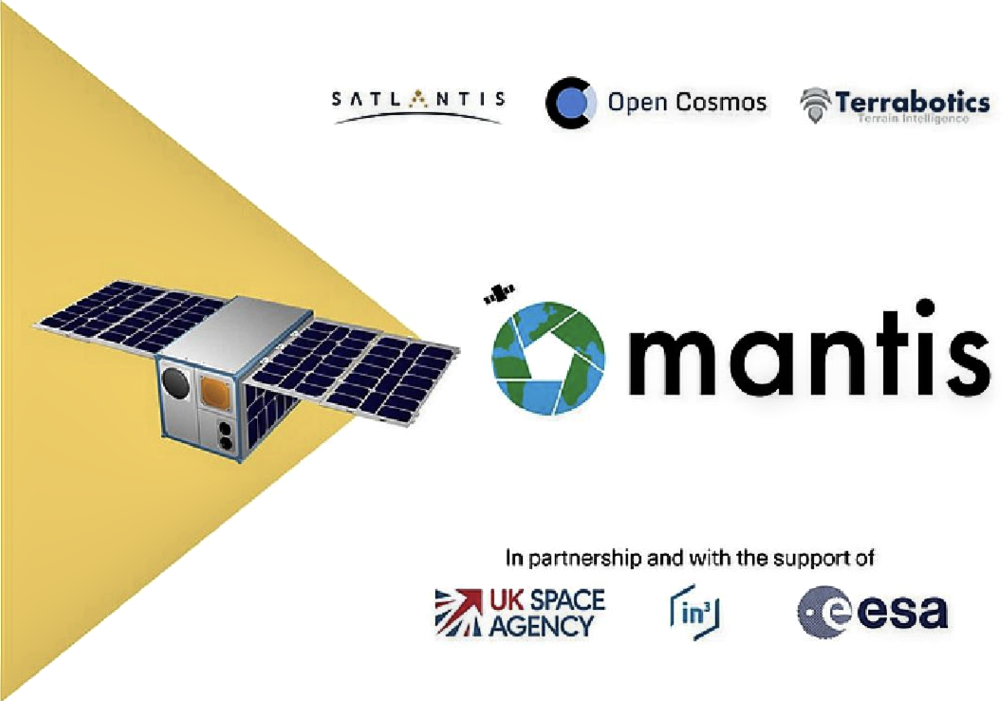
MANTIS was successfully integrated with its EXOpod Nova deployment system in Berlin, provided by Exolaunch as part of their mission management and integration service, prior to completing its integrations with SpaceX’s Falcon 9 before lift-off from Vandenberg Space Force Base.
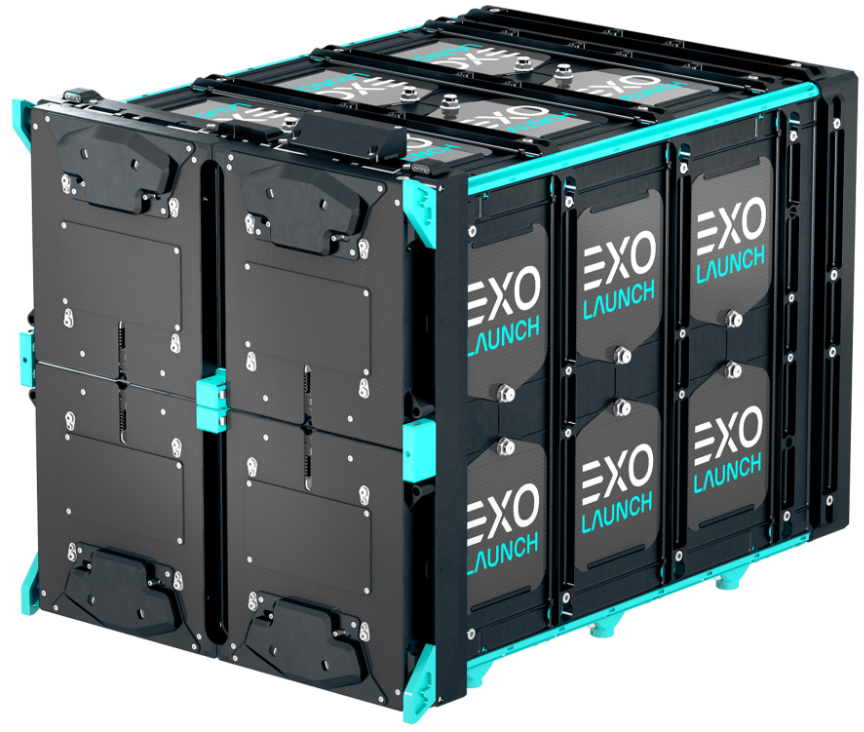
MANTIS, which stands for Mission Agile Nanosatellite for Terrestrial Imagery Services, will be the first satellite launched as part of ESA InCubed, the co-funding program run by ESA Φ-lab which focuses on commercial development activities across the entire Earth Observation (EO) value chain, including satellites, ground applications, downstream applications and new EO business models.

As a participating member state, the UK Space Agency has contributed £2.2 million of funding to this initiative in order to support the advancement of space-related innovation within the UK.

The satellite will host an innovative multispectral, high-resolution optical payload for EO and a secondary payload, a high-performance and reconfigurable processing unit aimed at exploiting the power of Artificial Intelligence (AI) to derive insights onboard.
It will also further sustainability by addressing the challenges of accessibility and periodicity in the energy and mining sector. Approximately 60% of the resources required within these supply chains can be found in remote and inaccessible locations necessitating ground stations with high costs to climate and biodiversity. EO data from MANTIS will reduce this requirement and create an efficient solution over a widespread area.
Outside of this sector, the data from MANTIS can be applied to further applications that will contribute to addressing environmental challenges and promoting sustainable development, such as climate change monitoring, deforestation and land use monitoring, water resource management, biodiversity conservation and sustainable agriculture.
As the prime contractor for MANTIS, Open Cosmos will oversee the end-to-end space mission service. This includes satellite design, integration of the payloads, build, launch, operations and dissemination of the data through their DataCosmos platform. Once operational, MANTIS will join the OpenConstellation, a global, shared Earth Observation (EO) satellite infrastructure built and managed by Open Cosmos which will enable anyone to access satellite data to address challenges around the climate crisis, energy, natural resources and more.
Deploying satellite infrastructure has, in the past, been prohibitively expensive. The OpenConstellation will allow national and regional governments, as well as businesses and organisations with more conservative budgets, to participate and access insightful, actionable data from space for the first time while keeping high levels of governance and security.
“MANTIS is an ambitious program and we’re excited to work with ESA to get this satellite into orbit in 2023. Once operational, MANTIS will allow us to better monitor our use of natural resources, allowing governments and organisations to make more informed decisions to support sustainable resource management practices. And by joining the OpenConstellation, the Earth Observation data derived from MANTIS will allow many other organisations to improve their impact, too.” — Aleix Megias, VP of Operations, Open Cosmos
“As the first InCubed co-funding of an end-to-end mission, MANTIS is a milestone for us and a salient example of the burgeoning commercial Earth observation sector in Europe, one of the priorities of ESA’s Agenda 2025. Open Cosmos has demonstrated a combination of technical excellence and customer focus that is sure to make the mission a success.”— Michele Casrtorina, Head of ESA Φ-lab Invest Office
“Observations of the Earth from space are helping us to monitor climate change, map our environment, forecast the weather and now, with this mission, finding new resources in a more sustainable way. MANTIS is an excellent example of how Earth observation satellites can provide novel solutions for a range of sectors. We’re delighted to have been able to support Open Cosmos and partners across the UK and Europe to deliver an innovative mission and drive growth in the sector.” — Harshbir Sangha, Missions and Capabilities Delivery Director, UK Space Agency
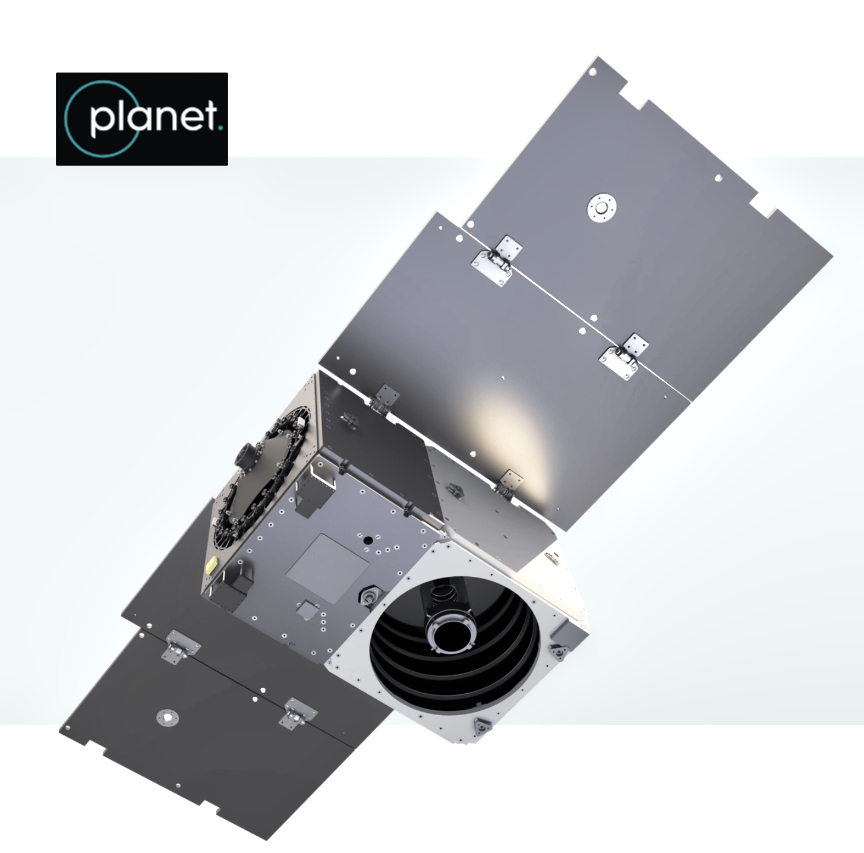
Planet Labs PBC (NYSE: PL) has announced that the company’s Pelican tech demonstration satellite, Pelican-1, along with 36 SuperDoves, have arrived at Vandenberg Space Force Base in preparation for launch next month.

Pelican-1, designed and manufactured by Planet, is the first tech demonstration of Planet’s next-generation, high-resolution fleet, which is expected to replenish and improve upon Planet’s existing high-resolution systems on-orbit today. The 36 SuperDoves, Planet’s Flock 4q, will contribute to Planet’s daily monitoring PlanetScope mission.
Pelican-1 is a technology demonstration, built to test Pelican’s integrated design and Planet’s common bus platform. This common bus platform, designed and built by Planet, will also host the Company’s future hyperspectral Tanager mission. Planet launches tech demonstrations across all of its new satellite fleets in order to prove out nexgen systems, test its latest technology, and learn from its performance, improving the scalability of its systems along the way.
Pelican-1 is not expected to produce commercial data, but rather obtain critical information and learnings needed to iterate the Pelican design and rapidly scale to a fleet using Planet’s agile aerospace approach. When fully operational, the Pelican constellation is planned to improve upon every dimension of Planet’s existing high-resolution SkySat constellation – faster acquisition and delivery of data, better spatial resolution to see finer details, higher revisit to catch fleeting events, and more ways to combine insights with other analytics and sensors.
The 36 SuperDoves launching will contribute to Planet’s flagship daily, global monitoring mission. This data is used by hundreds of customers in defense, civil government, and commercial markets to take informed action, and better contextualize events they’re seeing on the ground today. Planet’s daily scan and deep archive of data for every point on Earth is unique within the industry and provides customers with a continuous and complete view of their areas of interest. Further, the archive acts as a rich training ground for predictive machine learning and advanced artificial intelligence models, accelerating users’ ability to draw insights from the terabytes of data collected by Planet each day.
“The launch of our first Pelican tech demonstration marks an exciting milestone for us,” said . “This new spacecraft bus is an exquisite system that will underpin both our Pelican and Tanager fleets and we can’t wait to learn and iterate in our agile aerospace model. The 36 SuperDoves also launching are not to be overlooked. They will join the flock we have in-orbit today, which remains the largest earth imaging fleet, providing our unique daily scan that is helping to unlock new markets.” — Will Marshall, Co-Founder and CEO, Planet

Space Systems Command (SSC), the United States Space Force (USSF) field command responsible for acquiring, developing, and delivering resilient space capabilities, is now accepting applications for the organization’s inaugural Project Apollo cohort. Details and on-line applications can be found at this direct infopage… .

Project Apollo is a voluntary, collaborative, tech accelerator that brings U.S. companies, University Affiliated Research Centers (UARCs), Federally Funded Research and Development Centers (FFRDCs), industry experts, and Space Force Guardians together to solve critical challenges in space domain awareness. Collaborations are facilitated in three-month innovation cycles taking place at SSC’s newly opened Space Domain Awareness Tools, Applications and Technology (TAP) Lab in Colorado Springs. The first cycle starts on October 26th.
Filling gaps in space domain awareness is a top Department of Defense priority. According to Maj. Sean P. Allen, SSC TAP Lab chief, Project Apollo intends to fill those gaps quickly by providing a tools- and data-rich “sand box” for industry, academia and government to quickly formulate, test and prove solutions.
“Each innovation cycle is designed to target solutions at a Technology Level Readiness (TLR) of 4 or above that are scoped to address specific challenge statements provided to each cohort in advance,” said Allen.
Challenge statements for Project Apollo’s first cohort address space launch custody, object identification, and decision tools as follows:
Space Launch Custody: Using unclassified novel data, fusion, and analytic techniques (seismic, ionospheric, infrasonic, GPS telemetry, RF, neutrino, other), to detect space launches within seconds. Upon detection of a launch, predict the ascent trajectory, intermediate and final orbits. Provide these predictions to a space domain awareness sensor as a “cue” to reacquire and track the launch vehicle within seconds-to-minutes. Investment in this technology is warranted as no launch detection or early “cueing” capability exists for the commercial Space Domain Awareness Enterprise. Such a capability would enable rapid target acquisition, ID, and threat assessment of launches.
Object Identification (ID): From a set of features (behaviors, orbital data, photometry, radar cross section, RF emissions, other), classify and identify space objects within seconds. Evaluate potentially misidentified objects which may be adversary intelligence payloads or weapons. Nominate these for further investigation. Attempts to evade detection, tracking, and ID complicate defense from an attack. Examples may include covert operations or payloads, active satellites appearing dead, inactive, as debris, or otherwise plausibly deniable operations. Investment in this technology is warranted as camouflage, concealment, and deception are fundamental to warfare. Such a capability would aid in hostility assessments, response options, and prevent operational surprise.
Decision Aids: Given knowledge of the environment, status of assets (space, ground, links), and an evolving understanding of a threat, provide semi-automated, real-time, data-centric decision aids for an Operation C2 center. Decision aids should be simple and intuitive with little to no training needed. Decision aids may consider many factors such as: Objectives within an “OPLAN”, legal authorities, hostile act and intent criteria, engagement conditions, targeting criteria, collateral damage estimation, reporting requirements, coordination or liaison protocol with external organizations. This problem in particular is well suited for Artificial Intelligence.
Space Systems Command is the U.S. Space Force field command responsible for acquiring, developing, and delivering resilient capabilities to protect our nation’s strategic advantage in, from, and to space. SSC manages a $15 billion space acquisition budget for the Department of Defense and works in partnership with joint forces, industry, government agencies, academic and allied organizations to outpace emerging threats. Our actions today are making the world a better space for tomorrow.

Space Flight Laboratory (SFL) is celebrating 25 years of building smallsats that provide big returns for commercial, government, and research clients — established in 1998, SFL has built 70 operationally successful satellites. recording 270 years on-orbit for dozens of distinct smallsat missions.
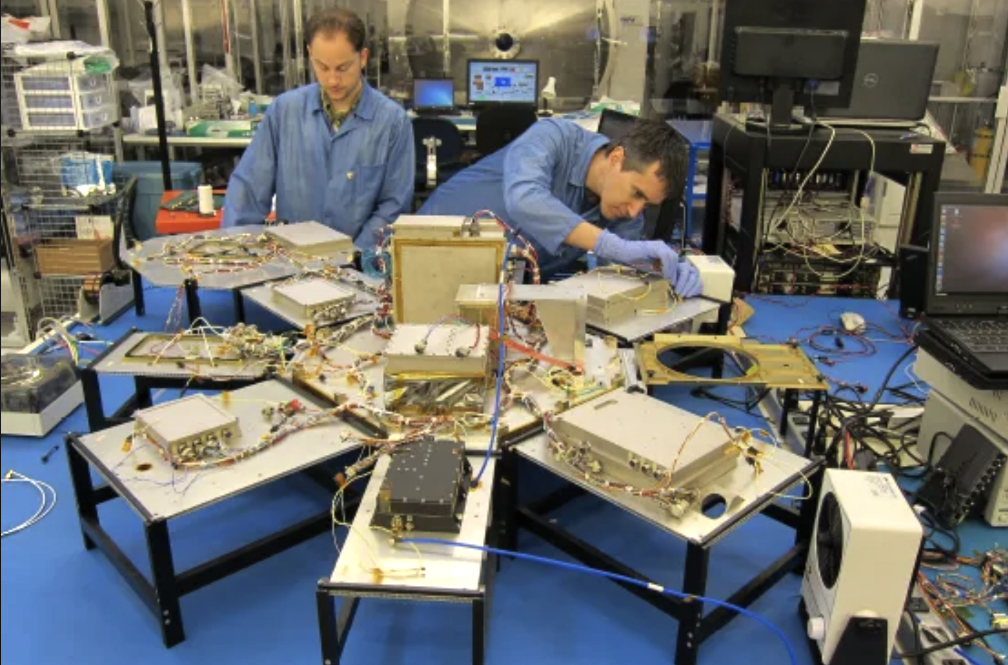
This year alone, the Toronto, Canada-based smallsat developer has seen 13 of the firm’s satellites launched and deployed, with another 26 satellites under development or awaiting launch. SFL’s record of accomplishments includes developing microspace missions for applications related to EO, atmospheric monitoring, ship tracking, telecommunications, RF geolocation, and space astronomy.
Pushing the envelope of what smaller satellites can accomplish, SFL has achieved microspace breakthroughs in space technology miniaturization including advanced attitude control for precise sensor pointing, drag sail deorbiting, autonomous formation flight, modular power systems, and custom deployables (e.g., antennas, solar panels, instrument shutters and doors) for small spacecraft.
Notable SFL missions include the following:
“For 25 years, SFL has focused on developing quality smaller satellites that achieve high levels of performance at price points affordable for customers in all sectors. By adhering to rigorous microspace development practices, we have stood the test of time, becoming a leading innovator of small satellites and cutting-edge technologies.”At SFL, we have built our reputation on developing smaller satellites that not only work the first time but exceed expectations both in terms of operational performance and lifespan.” — Dr. Robert E. Zee, Director, SFL
SFL offers a complete suite of nano-, micro- and small satellites – including high-performance, low-cost CubeSats – that satisfy the needs of a broad range of mission types from 3 to 500 kilograms. For a comprehensive list of SFL high-performance satellite platforms, please visit www.utias-sfl.net/satellite-platforms/overview/.